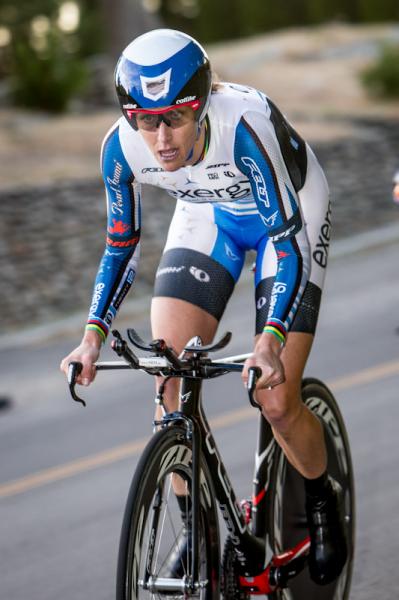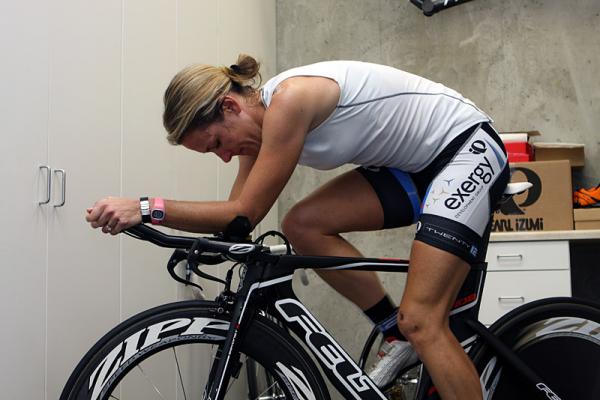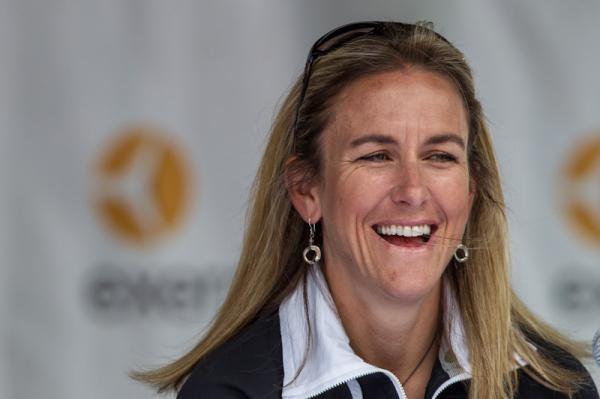Kristin Armstrong says she will be in top form for London Olympics
2008 Olympic TT champion more determined than ever following recent clavicle fracture



Kristin Armstrong told Cyclingnews Wednesday there is "no question" she will be in top form for the London Olympics if USA Cycling's selection committee puts her on the team when it announces its decision June 15.
"As far as being ready and being medal capable, which is what is described in all the selection procedures, yeah, there's no question," Armstrong said.
The 2008 Olympic time trial champion broke her clavicle May 24 after crashing during the prologue time trial of the Exergy Tour in her hometown of Boise, Idaho. Surgeons repaired the break with one screw the following morning, and she was at the finish of stage 1 just hours later to watch her Exergy-Twenty12 teammate Theresa Cliff-Ryan take the win.
Armstrong is in a tight battle for the two Olympic time trial spots the US has earned this year, competing neck-and-neck with a list of riders that includes Specialized-lululemon teammates Amber Neben and Evelyn Stevens, who finished 1-2 during the time trial stage of the Exergy Tour and then swapped spots for the overall.
While the final allocations have yet to be confirmed, the US will likely have two time trial spots and four road race spots for the London Games; the two riders selected for the time trial will also compete in the road race. Placing in the top three of the 2011 world championships was the only way to earn an automatic spot on the London time trial team, and because no rider achieved that result, both spots will be filled at the discretion of the five-rider selection committee. Dylan Casey, Jeanne Golay, Jeff Pierce, Alison Dunlap, Mike McCarthy, Dede Barry, Anton Quist and Eric Rupe will share the unenviable task of making the picks.
Neben and Armstrong previously battled to the wire for the time trial berth at last year's world championships, with Neben eventually getting the spot after successfully appealing the selection committee's decision to choose Armstrong over her. Armstrong had already traveled to Europe when the arbitrator made the ruling, and she found out about the decision just hours after landing in Denmark.
The two-time world champion seemed determined to leave no doubt this year, piling up a stack of early season results to try and put an exclamation mark on her Olympic bid.
The latest race content, interviews, features, reviews and expert buying guides, direct to your inbox!
Armstrong started her season in February at the Women's Tour of New Zealand, where she won the time trial and two more stages. She continued her momentum at home in March by taking a stage win and the overall crown at the Merco Classic, where she won the time trial by 55 seconds over Canadian Clara Hughes and 1:11 over Stevens. Armstrong topped Hughes again at the San Dimas Stage Race time trial in mid-March, winning two stages and the overall victory.
She crossed the pond after her early season wins to compete with the US national team in Europe, scoring second-place at the Tour of Flanders in a two-up sprint with Judith Arndt after the pair powered away on the Oude Kwaremont about 30 km from the finish.
Armstrong returned to the US at the beginning of May and dominated the Tour of the Gila in new Mexico, winning the overall and three of four stages. She took the 26.6 km time trial by more than two minutes over Alison Powers (Now and Novartis for MS) and Carmen Small (Optum Pro Cycling-Kelly Benefit Strategies) and followed that performance with a similar win at the women's time trial during the Tour of California.
She was primed to cap it off with a top performance among an international field at her hometown race before disaster struck. Armstrong set the fastest time at the intermediate check point for the 3.2km out-and-back course. She had set up for a tight left-hand turn when her front tire washed out and she fell hard on her shoulder. Armstrong was still clipped in the pedals and had trouble getting up, but she eventually remounted her bike and started pedaling for the line.
"Right then I thought 'god dang my shoulder hurts', and I said 'Oh, I just have to lose as little time as possible,'" Armstrong said. "And so adrenalin took me into the finish line."
Armstrong finished 13th, losing just eight seconds to stage winner Tara Whitten (TIBCO-To the Top), but she immediately started cradling her arm. Medics quickly swarmed the local hero, and her personal doctor, who happened to be at the race, gave her the bad news after a quick examination.
"Somebody said, 'Well don't you need X-rays?' Armstrong remembered. "And he's like, 'I've been around long enough. You see this bone sticking up? That's a broken clavicle.'"
X-rays confirmed the doctor's original diagnosis, but by then Armstrong had already turned her attention to her ongoing reach for another Olympic medal. Less than 12 hours after the crash she underwent surgery. Her physical therapist said she will be riding her time trial bike in tuck position within a few days.
"Kristin is progressing incredibly well and is far ahead of where I would expect her to be less than one week out," said Dave Fleckenstein, director of Orthopedic Rehab for St. Luke's Hospital in Boise. "We're already working on strength and will be back in the time trial position later this week. The biggest challenge is keeping Kristin from doing too much – I caught her lifting her son earlier this week."
Armstrong also got the go-ahead Wednesday to start riding her bicycle outdoors. She said she had already started riding her trainer briefly, heeding her doctor's advice to avoid the sweat that can cause infection before the surgical wounds heal, but now she will be able to put more time in on the road after just five days off.
"I was expecting to have to tough it out on the trainer for about a week, but it looks like I'm lucky and I don't have to," she said. "It means that I get can more miles in, because I am not one of those people who can sit on a trainer for hours. People tell me they read a book or watch a movie for four hours. I can't do it. I'd rather go hike."
The only interruption in her competition schedule leading up to the Olympics will be skipping the Mt. Hood Cycling Classic, where she wanted to race with the men, Armstrong said. She had already planned to skip the Nature Valley Grand Prix in Minnesota June 13-17, choosing to focus instead on USA Cycling Road Nationals June 20-24 in Augusta, Georgia. She'll race the Cascade Cycling Classic in Bend July 7-22 and then hopes to compete for her country one more time at the Olympics July 29 and August 1.
"The original plan after the Exergy Tour was to take a little bit of a break." she said. "I would take a few weeks to build a few miles and work into my threshold and build some strength, and I would top it off with racing. That was the original plan."
While a broken collarbone is obviously not ideal preparation for the Olympics, Armstrong said the injury could be a blessing in disguise, forcing her to refocus her efforts on leaving nothing undone in preparation for a contest that is usually decided by seconds.
"I think that drawing that focus back in, for an athlete, is key to making the difference on whether you win or maybe get fourth, fifth place," she said. "I think that drawing my focus back in and knowing that, OK, it's go time, I have to focus fully, is really good."
Armstrong appears more determined than ever to compete and perform in London, saying that if anything, the crash will ensure she avoids the complacency that can set in when success comes too often.
"One of my favorite quotes is, 'You learn to win by learning to lose,' and that happens a lot," she said. "You know, you go and win a race and you go home and you think you're doing everything right. But you go home from a race and you got second, and I'm telling you that person who got second place learned a lot more that day. They're ready to come out and take you down."
Growing up in Missoula, Montana, Pat competed in his first bike race in 1985 at Flathead Lake. He studied English and journalism at the University of Oregon and has covered North American cycling extensively since 2009, as well as racing and teams in Europe and South America. Pat currently lives in the US outside of Portland, Oregon, with his imaginary dog Rusty.
